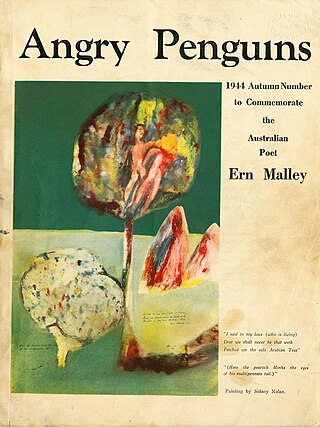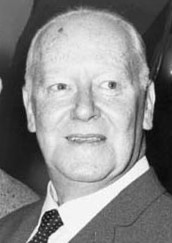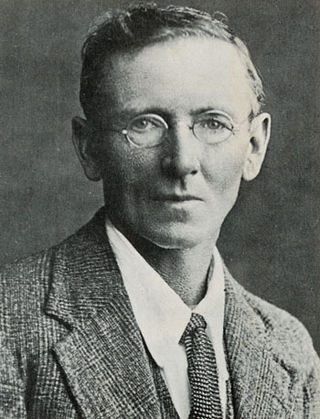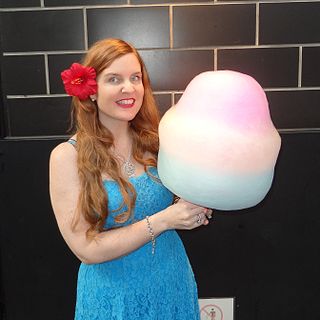Related Research Articles

Andrew Barton "Banjo" Paterson, was an Australian bush poet, journalist and author. He wrote many ballads and poems about Australian life, focusing particularly on the rural and outback areas, including the district around Binalong, New South Wales, where he spent much of his childhood. Paterson's more notable poems include "Clancy of the Overflow" (1889), "The Man from Snowy River" (1890) and "Waltzing Matilda" (1895), regarded widely as Australia's unofficial national anthem.

The Ern Malley hoax, also called the Ern Malley affair, is Australia's most famous literary hoax. Its name derives from Ernest Lalor "Ern" Malley, a fictitious poet whose biography and body of work were created in one day in 1943 by conservative writers James McAuley and Harold Stewart in order to hoax the Angry Penguins, a modernist art and literary movement centred around a journal of the same name, co-edited by poet Max Harris and art patron John Reed, of Heide, Melbourne.

Barcroft Henry Thomas Boake was an Australian stockman and poet who wrote primarily within the bush poetry tradition. He was active for only a few years before his suicide at the age of 26.

Edwin James Brady was an Australian journalist and poet.

Kenneth Adolphe Slessor was an Australian poet, journalist and official war correspondent in World War II. He was one of Australia's leading poets, notable particularly for the absorption of modernist influences into Australian poetry. The Kenneth Slessor Prize for Poetry is named after him.

John Shaw Neilson was an Australian poet. Slightly built, for most of his life he worked as a labourer, fruit-picking, clearing scrub, navvying and working in quarries, and, after 1928, working as a messenger with the Country Roads Board in Melbourne. Largely untrained and only basically educated, Neilson became known as one of Australia's finest lyric poets, who wrote a great deal about the natural world, and the beauty in it.
Francis Charles Webb-Wagg was an Australian poet who published under the name Francis Webb. Diagnosed as suffering from schizophrenia in the 1950s, he spent most of his adult life in and out of psychiatric hospitals. His output was prolific and his work has often been published in anthologies.

John Ernest Tranter was an Australian poet, publisher and editor. He published more than twenty books of poetry; devising, with Jan Garrett, the long running ABC radio program Books and Writing; and founding in 1997 the internet quarterly literary magazine Jacket which he published and edited until 2010, when he gave it to the University of Pennsylvania.

Leslie Allan Murray was an Australian poet, anthologist, and critic. His career spanned over 40 years and he published nearly 30 volumes of poetry as well as two verse novels and collections of his prose writings.
Nationality words link to articles with information on the nation's poetry or literature.
Performance poetry is poetry that is specifically composed for or during a performance before an audience. During the 1980s, the term came into popular usage to describe poetry written or composed for performance rather than print distribution, mostly open to improvisation. From that time performance poetry in Australia has found new venues, audiences and expressions.
Bertram William Mathyson Francis Stevens was Australian journal editor ; literary and art critic; and anthologist.

Alfred George Stephens, commonly referred to as A. G. Stephens, was an Australian writer and literary critic, notably for The Bulletin. He was appointed to that position by its owner, J. F. Archibald in 1894.
Nationality words link to articles with information on the nation's poetry or literature.

Ian Mayelston Mudie was an Australian poet and author.
Douglas Stewart was a major twentieth century Australian poet, as well as short story writer, essayist and literary editor. He published 13 collections of poetry, 5 verse plays, including the well-known Fire on the Snow, many short stories and critical essays, and biographies of Norman Lindsay and Kenneth Slessor. He also edited several poetry anthologies.
David Watt Ian Campbell was an Australian poet who wrote over 15 volumes of prose and poetry. He was also a talented rugby union player who represented England in two tests.
This article presents a list of the historical events and publications of Australian literature during 1951.
This article presents a list of the historical events and publications of Australian literature during 1864.

Cassandra Atherton is an Australian prose-poet, critic, and scholar. She is an expert on prose poetry, contemporary public intellectuals in academia, and poets as public intellectuals, especially hibakusha poets. She is married to historian Glenn Moore.
References
- 1 2 3 4 Austlit - Sydney Jephcott
- ↑ Stewart, Ken. "Jephcott, Sydney Wheeler (1864–1951)". Australian Dictionary of Biography. National Centre of Biography, Australian National University – via Australian Dictionary of Biography.
- 1 2 "Sydney Jephcott" Daily Mercury, 1 September 1951, p2
- 1 2 "Poet of the Murray dies at 89" The Argus, 5 July 1951, p7